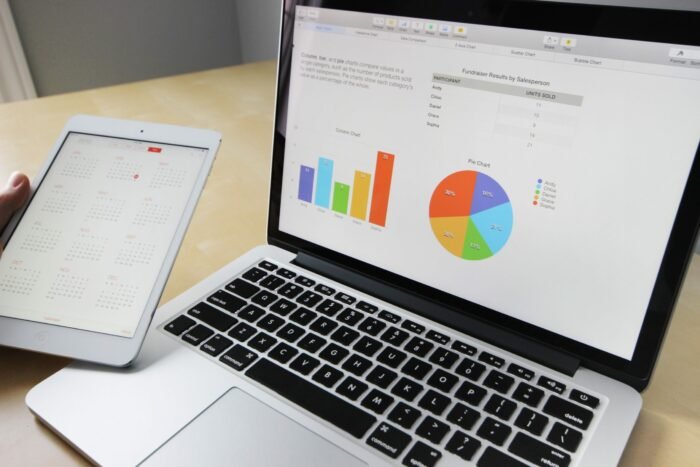Welcome to the digital age, where technology has become an integral part of our daily lives. From smartphones that keep us connected to cloud-based platforms that streamline our workflows, there is no denying the power of technology in enhancing productivity. But with so many tools and gadgets available, how can we effectively manage and leverage technology for maximum gains? In this blog post, we will explore effective techniques for harnessing the power of technology to boost your productivity and propel you towards success. Whether you’re a freelancer, entrepreneur, or corporate professional, these strategies will help you navigate the ever-evolving tech landscape and make it work for you. So let’s dive in and discover how to unlock the full potential of technology for greater efficiency and achievement!
Effective Techniques for Managing and Leveraging Technology for Productivity gains
Harnessing the Power of Technology: Strategies for Productivity Enhancement
In today’s fast-paced world, harnessing the power of technology is essential for enhancing productivity. But where do you start?
- It all begins with selecting the right tools that align with your workflow and goals. Identify your specific needs and objectives. Are you looking to streamline communication or automate repetitive tasks? Understanding what you want to achieve will guide your decision-making process.
- Next, research different technology solutions available in the market. Look for reliable software applications or platforms that offer features tailored to your requirements. Consider factors such as user-friendliness, compatibility with existing systems, and customer support.
- Once you have chosen your tools, it’s time to integrate them seamlessly into your workflow. Take advantage of automation capabilities to streamline repetitive tasks and eliminate manual errors. This will free up valuable time and energy for more important activities.
- To ensure easy access and retrieval of digital assets, organize files and documents systematically. Use cloud storage services or file management software to categorize information effectively. Implement a consistent naming convention for files so that they can be easily searched when needed.
- Collaboration is key in any productive environment. Leverage collaboration tools like project management platforms or team chat apps to enhance teamwork and communication among colleagues. These tools facilitate seamless sharing of ideas, feedback exchange, task delegation, and progress tracking – all contributing towards improved productivity.
- Stay on top of your schedule by utilizing time tracking and productivity apps that help manage work hours efficiently. These apps allow you to record how much time is spent on each task/project, set priorities accordingly, track progress against deadlines – enabling effective time management practices.
- As we rely more on technology for our work processes, cybersecurity becomes paramount in protecting sensitive data from potential threats. Invest in robust antivirus software programs along with regular backups of important files to safeguard productivity gains from potential disasters or cyber-attacks.
While technology offers numerous benefits for productivity enhancement, it also brings various distractions that can hinder focus during work hours.
Selecting the Right Tools: Choosing Technology Solutions for Your Workflow
If choosing technology solutions for your workflow:
- When it comes to managing and leveraging technology for productivity gains, one of the crucial steps is selecting the right tools for your workflow. With a myriad of options available in the market, it can be overwhelming to choose the most suitable technology solutions. However, by considering a few key factors, you can make an informed decision.
- Assess your specific needs and goals. What tasks do you need assistance with? Are you looking for software that streamlines project management or communication within your team? Understanding your requirements will help narrow down the options.
- Consider compatibility and integration capabilities. Will the chosen tool seamlessly integrate with existing systems and software used in your organization? Ensuring smooth interoperability is essential to avoid any disruptions in workflows.
- Furthermore, evaluate user-friendliness and ease of implementation. Look for tools that have intuitive interfaces and provide comprehensive onboarding support. This will minimize training time and allow employees to quickly adapt to new technologies.
- Another important aspect is scalability. As your business grows, so should your technology solutions. Opting for tools that can accommodate increasing demands will prevent future bottlenecks or limitations.
- Additionally, take into account reliability and customer support offered by vendors. It’s crucial to partner with reputable providers who offer prompt assistance when technical issues arise.
- Consider cost-effectiveness without compromising quality or functionality. Compare pricing plans from different vendors while keeping long-term benefits in mind.
By carefully considering these factors during the selection process, you can choose technology solutions that seamlessly align with your workflow needs – ultimately enhancing productivity across all aspects of your business operations!
Automating Repetitive Tasks: Streamlining Efficiency with Technology
In today’s fast-paced digital world, time is of the essence. And when it comes to repetitive tasks that eat up valuable hours, technology can be a game-changer. By automating these mundane and repetitive activities, you can streamline your workflow and free up time for more important tasks:
- One effective technique for automating repetitive tasks is using task management software or project management tools. These tools allow you to create workflows and set up automated processes that eliminate manual intervention. For example, you can automate email responses, file backups, data entry tasks, or even social media posting.
- Another way to leverage technology for streamlining efficiency is by utilizing chatbots or virtual assistants. These AI-powered tools can handle customer inquiries, schedule appointments, or perform routine administrative tasks without human involvement. This not only saves time but also improves customer satisfaction by providing instant responses.
- Additionally, incorporating robotic process automation (RPA) into your workflow can significantly enhance productivity. RPA involves using software robots to mimic human actions and complete rule-based tasks swiftly and accurately. This technology eliminates errors caused by human factors while ensuring consistent results.
- Furthermore, adopting machine learning algorithms or artificial intelligence capabilities can further optimize productivity gains through automation. These technologies analyze large volumes of data to identify patterns and make predictions automatically.
By leveraging these advanced technologies in automating repetitive tasks, businesses can achieve higher levels of efficiency and productivity gains never before possible!
Organizing Digital Assets: Managing Files and Documents for Easy Access
In today’s digital age, managing files and documents can be a daunting task. With the abundance of information available at our fingertips, it’s easy to get overwhelmed by the sheer volume of data. That’s why organizing your digital assets is crucial for improved productivity:
- One effective technique for managing files is to create a logical folder structure. By categorizing your documents into relevant folders and subfolders, you can easily locate specific files when needed. This not only saves time but also reduces frustration in searching through cluttered directories.
- Another helpful strategy is to use descriptive file names. Instead of generic labels like “Document1” or “Untitled,” give your files meaningful titles that reflect their content. This makes it easier to identify files at a glance and eliminates confusion.
- Utilizing tags or metadata is another valuable tool for organizing digital assets. Tags are keywords or labels that you assign to files, making them searchable based on specific criteria such as project name, client, or topic. Metadata provides additional information about a file, such as creation date or authorship details.
- Implementing document management software can also greatly enhance organization efforts. These tools offer features like version control, document tracking, and advanced search capabilities—making it simpler than ever before to find and manage important documents efficiently.
By taking advantage of these techniques and leveraging technology solutions tailored to your workflow needs, you can streamline access to your digital assets while maximizing productivity gains in the process.
Collaboration Tools: Enhancing Teamwork and Communication
Collaboration is key in today’s fast-paced, interconnected work environments. To enhance teamwork and communication, businesses are turning to collaboration tools that leverage technology to streamline processes and foster better collaboration among team members:
- One popular collaboration tool is project management software. This tool allows teams to plan and track projects, assign tasks, set deadlines, and monitor progress all in one centralized platform. With real-time updates and notifications, everyone on the team stays informed about project status and can easily collaborate on tasks.
- Another effective tool for enhancing teamwork is cloud-based file sharing platforms. These platforms enable easy document sharing and editing among team members regardless of their physical location. By storing files in the cloud, individuals can access them from anywhere at any time, making it easier than ever to collaborate on documents.
- Virtual communication tools are also essential for remote teams or those working across different locations. Video conferencing solutions allow face-to-face interactions even when team members are miles apart. Instant messaging apps facilitate quick conversations and provide a platform for ongoing discussions throughout the day.
- In addition to these tools, collaborative task management software helps break down projects into smaller tasks that can be assigned to individual team members with specific due dates attached. This ensures accountability while promoting transparency within the team.
By leveraging these collaboration tools effectively, businesses can enhance productivity by improving communication flow among employees, reducing miscommunication errors or delays caused by traditional methods such as emails or phone calls alone.
Time Tracking and Productivity Apps: Maximizing Time Management
Time management is essential for productivity, and technology has made it easier than ever to track and manage our time effectively. With the multitude of time tracking and productivity apps available, staying organized and focused has never been simpler.
These apps allow us to set goals, prioritize tasks, and allocate specific amounts of time to each activity. By using timers or setting reminders, we can stay on track and ensure that we make progress towards our objectives:
- One popular time tracking app is Toggl, which allows users to monitor their activities in real-time. It provides detailed reports on how much time is spent on different tasks or projects. This information can be invaluable when it comes to identifying areas where improvements can be made.
- Another useful app is RescueTime, which runs in the background of your device and tracks how you spend your digital hours. It provides insights into how much time you spend on various websites or applications so that you can identify any potential distractions or unproductive habits.
- For those who prefer a more gamified approach to productivity, Habitica might be the perfect choice. This app turns task completion into a game by rewarding users with virtual coins or leveling up their characters when they complete their designated tasks.
- The key to maximizing the benefits of these apps lies in finding one that suits your needs and preferences. Experimenting with different options will help you discover what works best for you in terms of interface design, features offered, and compatibility with other tools you use.
With the right time tracking and productivity apps at your disposal, managing your schedule becomes a breeze. Take advantage of this technology to boost efficiency levels by prioritizing tasks wisely while minimizing wasted time throughout your day!
Cybersecurity and Data Protection: Safeguarding Productivity with Technology
Cybersecurity and data protection have become crucial components of managing and leveraging technology for productivity gains. In today’s digital era, where information is constantly at risk of being compromised, it is essential to safeguard your organization’s sensitive data:
- One effective technique for ensuring cybersecurity is implementing robust security measures such as firewalls, antivirus software, and encryption tools. These technologies act as a protective shield against potential threats and unauthorized access to your systems.
- Regularly updating software and conducting vulnerability assessments are also vital in maintaining a secure environment. By staying ahead of emerging cyber threats, you can prevent potential breaches that could disrupt productivity.
- Employee education plays a significant role in promoting cybersecurity awareness within an organization. Training programs can teach staff members about best practices for handling sensitive data, recognizing phishing attempts, and utilizing strong passwords.
- Implementing multi-factor authentication adds an extra layer of protection by requiring users to provide additional credentials when accessing important accounts or systems. This helps minimize the risk of unauthorized access even if passwords are compromised.
- Backing up critical data regularly ensures that valuable information remains safe in case of any unforeseen events like system failures or ransomware attacks. Cloud-based backup solutions offer convenient and secure options for protecting your digital assets.
- To enhance productivity while maintaining security standards, organizations should consider using virtual private networks (VPNs) when employees need remote access to company resources or when working from public Wi-Fi networks. VPNs encrypt internet connections, making it difficult for hackers to intercept sensitive information transmitted over the network.
By prioritizing cybersecurity measures and investing in appropriate technologies, businesses can protect their digital assets while maximizing productivity gains. Safeguarding against potential threats allows teams to focus on their work without fear of compromising confidential information or experiencing disruptive incidents.
Managing Digital Distractions: Strategies for Focused Work in the Digital Age
In today’s digital age, staying focused on work can be a challenge. With constant notifications, social media temptations, and an abundance of online distractions, maintaining productivity can feel like an uphill battle. However, by implementing effective strategies to manage digital distractions, you can regain control over your focus and boost your productivity:
- One key strategy is to create designated “focus blocks” of uninterrupted time. During these periods, turn off all non-essential notifications and close any unnecessary tabs or applications on your computer. By creating a distraction-free environment, you’ll find it easier to stay focused on the task at hand.
- Another helpful technique is to utilize website blockers or apps that limit access to distracting websites or apps during specific times of the day. These tools allow you to set boundaries and prevent yourself from mindlessly scrolling through social media or getting lost in an endless stream of cat videos.
- Additionally, practicing mindfulness techniques can be beneficial in managing digital distractions. Taking short breaks throughout the day for meditation or deep breathing exercises helps clear your mind and refocus your attention on what truly matters.
- Furthermore, organizing your digital workspace can minimize visual clutter and reduce potential distractions. Create folders for different projects or categories so that files are easily accessible when needed but not constantly visible as a source of distraction.
- It’s also important to set realistic goals and prioritize tasks effectively. Breaking down larger projects into smaller actionable steps allows you to focus on one task at a time without feeling overwhelmed by the magnitude of the entire project.
- Don’t underestimate the power of accountability partners or support groups who share similar goals. Engaging with others who are striving for focused work can provide encouragement and motivation while holding each other accountable for minimizing distractions.
By implementing these strategies for managing digital distractions in the workplace, you’ll be able to achieve heightened levels of focus and productivity even in this digitally saturated world we live in. So, take control of your attention, harness the power of technology, and become the master of your digital domain.
Adopting Mobile Productivity: Leveraging Technology for Work on the Go
In today’s fast-paced world, being able to work efficiently and effectively while on the go is crucial. With the advancements in technology, mobile productivity has become increasingly accessible and powerful. Whether you’re a freelancer, a remote worker, or someone who frequently travels for business, leveraging technology can significantly enhance your productivity:
- One of the key advantages of mobile productivity is the ability to access your work from anywhere at any time. With cloud-based storage solutions like Google Drive or Dropbox, you can easily sync and access your documents, presentations, and spreadsheets across multiple devices. This means that even if you forget to bring your laptop to a meeting or conference, you can still access all your important files from your smartphone or tablet.
- Mobile apps have also revolutionized how we manage our tasks and stay organized on the go. From note-taking apps like Evernote to project management tools like Trello or Asana, there are countless options available that allow us to keep track of our deadlines, prioritize tasks, and collaborate with teammates seamlessly – all from our mobile devices.
- Another aspect of mobile productivity is communication. With messaging apps such as Slack or Microsoft Teams installed on our smartphones, we can stay connected with colleagues in real-time no matter where we are. This eliminates delays in response time and enhances teamwork by enabling quick collaboration and decision-making even when team members are physically apart.
- Moreover, mobile devices offer various built-in features that help us stay productive throughout the day. For example, voice assistants like Siri or Google Assistant enable hands-free operation allowing us to make calls, schedule meetings or set reminders without having to type anything.
Staying Up-to-Date: Continuous Learning and Skill Development in the Digital Era
In today’s fast-paced digital era, staying up-to-date with the latest trends and advancements is crucial for continuous learning and skill development. Technology is constantly evolving, and if you want to remain competitive in your field, it’s essential to keep enhancing your knowledge:
- One effective way to stay current is by actively seeking out relevant information through various channels. Follow industry experts on social media platforms or subscribe to newsletters that provide valuable insights and updates. Engage in online forums or communities where professionals discuss emerging technologies and share their experiences.
- Attending conferences, workshops, or webinars is another excellent opportunity to expand your knowledge base. These events offer a platform for networking with like-minded individuals while gaining valuable insights from industry leaders.
- Taking advantage of online learning platforms can also aid in skill development. Many websites offer courses on a wide range of topics at affordable prices or even free of charge. Whether it’s coding, graphic design, data analysis, or project management – there are numerous options available that cater to different interests and career paths.
- Additionally, joining professional associations related to your field can be highly beneficial. These organizations often organize seminars and training sessions specifically designed for members’ professional growth. They also provide access to resources such as research papers, case studies, and best practices that can further enhance your skills.
- Lastly but importantly: never underestimate the power of self-learning! Take initiative by exploring new tools or software independently. Tutorials are widely available online for almost any technology you might encounter – so seize the opportunity!
Remember that continuous learning goes hand-in-hand with adaptability in this ever-changing digital world we live in today! By embracing technology as a tool for personal growth and improvement, you’ll ensure yourself a bright future filled with endless possibilities.
Conclusion
In today’s fast-paced and digital world, effectively managing and leveraging technology is crucial for enhancing productivity. By harnessing the power of technology and utilizing the right tools, individuals and teams can streamline their workflows, automate repetitive tasks, organize digital assets, enhance collaboration, track time efficiently, protect data security, minimize distractions, adopt mobile productivity solutions, and stay up-to-date with continuous learning. However, it is important to remember that technology alone cannot guarantee productivity gains. It is essential to strike a balance between utilizing technology as a tool while also maintaining focus and discipline in our work habits. By combining effective techniques with mindful practices such as setting priorities, establishing routines, practicing good time management skills, minimizing distractions when needed and taking breaks to recharge ourselves mentally and physically – we can truly leverage the benefits of technology for increased productivity.
So embrace the opportunities that modern technology provides us but always remember that true effectiveness lies in how we manage and utilize these tools. With careful consideration of our goals and needs combined with conscious effort towards improving our work habits – we can unlock the full potential of technology for optimal productivity gains.









![Cybersecurity Awareness for Administrative Professionals [Best 8] 10 Cybersecurity Awareness for Administrative Professionals](https://zoets.b-cdn.net/wp-content/uploads/2024/01/pexels-dan-nelson-3949100-scaled-e1704210117617.jpg)



